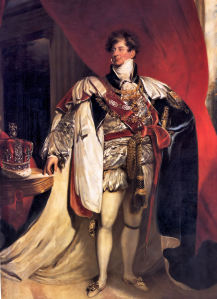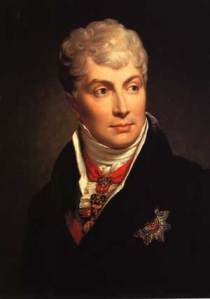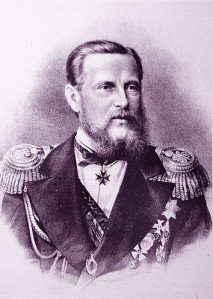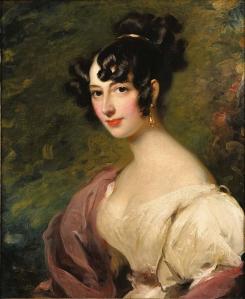 “You are a man, you are strong. I myself am weak, very weak. I obviously do not know how to make myself understood if you have not perceived the pleasure your presence gives me.” The Princess von Lieven wrote this to Guizot on March 19, 1837 pronouncing the words that he was prepared to hear as, three months later, he told her “You are no longer alone”, thus initiating a relationship that would last for twenty years. They were indeed both alone, for, despite a very full social life, Guizot, widowed since 1833, had just lost his eldest son François and the Princess, separated from her husband who was to die in 1839, had lost in the spring of 1835 two young sons aged 10 and 14.
“You are a man, you are strong. I myself am weak, very weak. I obviously do not know how to make myself understood if you have not perceived the pleasure your presence gives me.” The Princess von Lieven wrote this to Guizot on March 19, 1837 pronouncing the words that he was prepared to hear as, three months later, he told her “You are no longer alone”, thus initiating a relationship that would last for twenty years. They were indeed both alone, for, despite a very full social life, Guizot, widowed since 1833, had just lost his eldest son François and the Princess, separated from her husband who was to die in 1839, had lost in the spring of 1835 two young sons aged 10 and 14.
Dorothée von Benckendorff, born in 1785 was from Estonian origins and brought up in Saint Petersburg. In 1800 she had married Count, later in 1826 becoming Prince Christophe von Lieven, a Livonian aristocrat appointed ambassador to Berlin by the Tsar Alexander Iin 1810, then ambassador to London two years later. Mme von Lieven was then to become the archetypal ambassadress, reigning in London over high society and having considerable influence in the courts of Europe due to her interpersonal skills, her availability and the charm of her conversation. She was the mistress of the Prince of Wales and future George IV, of Metternich, the Grand-Duke Constantine of Russia and other powerful political figures.
Using her body as a means to an end, she believed she also had a flair for politics and convinced others of such. For a woman, even of her status, her network of connections at the end of the 1820’s was unequalled in Europe. In 1834, the Lievens had to leave the embassy. She settled in Paris alone in September 1835, and was received with curiosity by high society. Her salon soon became very popular and she launched herself into French politics with passion. Her friend Lady Granville, wife of the British ambassador to Paris, said of her “she is a purely political woman, she must have the people in power. If today the executioner was appointed President of the Council she would be delighted to receive him in her home”. She began with Thiers, doing everything in her power to make him President of the Council in 1836. But she was also keeping an eye on his rival, François Guizot. They really came to know one another at the beginning of 1836 but maintained a certain distance throughout that year before the revelation of 1837 which was finally consummated, it would seem, in mid-summer: “August 30th was a Sunday, she wrote to him. Tomorrow, it will have been eight weeks since we solemnly gave ourselves to one another, for this life and for eternity! Farewell, my beloved darling.” This liaison, the intensity of which never diminished despite their increasing age, was of public notoriety and gave rise to a magnificent correspondence that was as much about their feelings for one another as about politics. When Guizot became ambassador to London in 1840, the Princess prepared the way for him and soon joined him there. The fact that the mistress of the Minister of Foreign Affairs was a Russian subject set tongues wagging. Chateaubriand said mockingly: “a serious doctrinaire has fallen at the feet of Omphale”; another newspaper described Guizot as “the devoted escort of a Chancellery goddess”. However, it would not appear that she had any influence on decisions regarding the country’s foreign policy, even if she did not hesitate to express her opinion. The essence of their relationship was situated on another level.
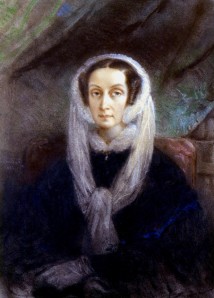 Dorothée von Lieven in fact remained unfailingly attached to the fallen statesman who was soon to retire. They had left for England at almost the same time in 1848 and both returned eighteen months later. He continued to frequent and enliven her salon in the rue Saint-Florentin, which regained its prestige under the second Empire and where she died during the night of January 26th to 27th 1857, after receiving the Protestant minister Cuvier as she had always maintained her attachment to the Lutheran church. Guizot was with her in her last moments and her death caused him great suffering. These two people had really loved one another.
Dorothée von Lieven in fact remained unfailingly attached to the fallen statesman who was soon to retire. They had left for England at almost the same time in 1848 and both returned eighteen months later. He continued to frequent and enliven her salon in the rue Saint-Florentin, which regained its prestige under the second Empire and where she died during the night of January 26th to 27th 1857, after receiving the Protestant minister Cuvier as she had always maintained her attachment to the Lutheran church. Guizot was with her in her last moments and her death caused him great suffering. These two people had really loved one another.
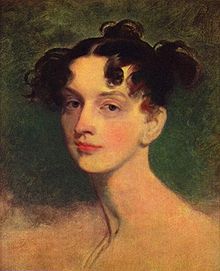 Was this despite all that separated them, or because of their differences? Dorothée von Lieven, an aristocrat, knew nothing about life beyond her social sphere, was indifferent to the arts except for music, had no taste for reading or curiosity about ideas in general, no true friends, hiding her sensitivity to the extent that people believed she had none, and was often mournful. But she found in the tirelessly hardworking, immensely cultivated bourgeois endowed with many friends and loved ones, very sure of himself, a force to which she submitted and by raising her to his level, he enabled her to discover within herself unexpected personal resources. If Rémusat saw her as “a tall red crane” and Thiers, who had fallen out with her, as “a gossipmonger, a liar and a fool” Barante, on her death, saluted “a person of great reason with a noble and steadfast character”. And Guizot himself thought well of her; “Her qualities were hers alone and came from her nature; her faults originated from her education and her social environment”.
Was this despite all that separated them, or because of their differences? Dorothée von Lieven, an aristocrat, knew nothing about life beyond her social sphere, was indifferent to the arts except for music, had no taste for reading or curiosity about ideas in general, no true friends, hiding her sensitivity to the extent that people believed she had none, and was often mournful. But she found in the tirelessly hardworking, immensely cultivated bourgeois endowed with many friends and loved ones, very sure of himself, a force to which she submitted and by raising her to his level, he enabled her to discover within herself unexpected personal resources. If Rémusat saw her as “a tall red crane” and Thiers, who had fallen out with her, as “a gossipmonger, a liar and a fool” Barante, on her death, saluted “a person of great reason with a noble and steadfast character”. And Guizot himself thought well of her; “Her qualities were hers alone and came from her nature; her faults originated from her education and her social environment”.
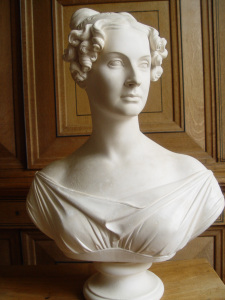 Although they saw one another several times a day in Paris, and wrote to one another almost daily when separated, they never lived together and certainly never married, as rumour had it. Despite many attempts, the Princess never managed to force her way into the family circle, neither in Paris nor in Val Richer. Mme Guizot the elder was jealous of her son’s over-absorbing liaison, the children were uncomfortable in her presence whilst always making an effort to be polite. She left him an annuity of 8000 francs and her carriage. He wrote her biographical notice declaring; “Truth and trust have always been the mainstays of our friendship, hence its solidity and its gentleness”. She was buried in the family estate of Mesoten, near Mitau in Courland. Her portrait by Thomas Lawrence and her bust by Thomas Campbell, placed in a prominent position in Val Richer, show that although she was not formerly a real beauty, she at least had elegance and grace.
Although they saw one another several times a day in Paris, and wrote to one another almost daily when separated, they never lived together and certainly never married, as rumour had it. Despite many attempts, the Princess never managed to force her way into the family circle, neither in Paris nor in Val Richer. Mme Guizot the elder was jealous of her son’s over-absorbing liaison, the children were uncomfortable in her presence whilst always making an effort to be polite. She left him an annuity of 8000 francs and her carriage. He wrote her biographical notice declaring; “Truth and trust have always been the mainstays of our friendship, hence its solidity and its gentleness”. She was buried in the family estate of Mesoten, near Mitau in Courland. Her portrait by Thomas Lawrence and her bust by Thomas Campbell, placed in a prominent position in Val Richer, show that although she was not formerly a real beauty, she at least had elegance and grace.
